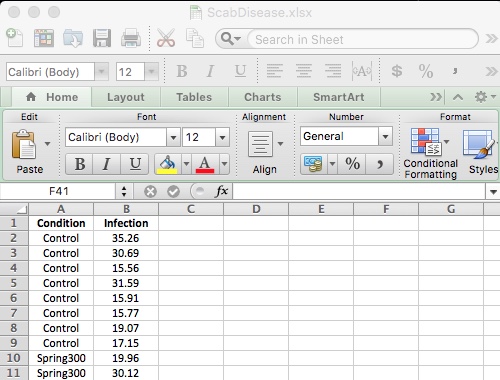
Scab Disease Data
Scab disease is a fungal infection that affects potatoes. The fungus does not grow well in acidic soil, so investigators designed a study to see whether adding sulphur to the soil would reduce the scab disease. In a completely randomized design, plots of land were randomly assigned to either a control condition or to several levels of sulphur that was spread on the land in the Spring or Fall. The amounts of sulphur were either 300 pounds per acre, 600 pounds per acre or 1200 pounds per acre. The potatoes were harvested at the end of the growing season. One hundred potatoes were randomly selected from each plot of land. The potatoes were washed, and then a lab assistant estimated the percent of each potato's surface that was infected with scab disease. The response variable is, for each plot of land, the mean percent of the potato's surface covered with scab disease. The explanatory variable is pounds of sulphur, in hundreds of pounds; the control is zero.
The data are in a spreadsheet that looks like this.

Click here to download the spreadsheet.
Here are some questions we would like to answer. Use SAS. For each question, start by stating the null hypothesis in terms of μj values.
Suppose we want to protect all these tests simultaneously at a joint significance level of 0.05.
Of course for each question you should be able to give the test statistic, p-value, and state the conclusion in plain, non-statistical language.
There are so many good questions and discussion topics that could be based on this example.
This document is based on an example in Cochran and Cox's (1958) classic text Experimental design.. The original data appear on page 97 of Cochran and Cox's book. The data above are carefully designed to give the same results as the original, without actually using their numbers. The R function used to reconstruct the data appears in a comment statement at the end of this document. View the html source to see it.
This document, including the data and the R function, is licensed under a Creative Commons Attribution-ShareAlike 3.0 Unported License. Use any part of it almost any way you like, as long as you share the results freely. See the license for details.